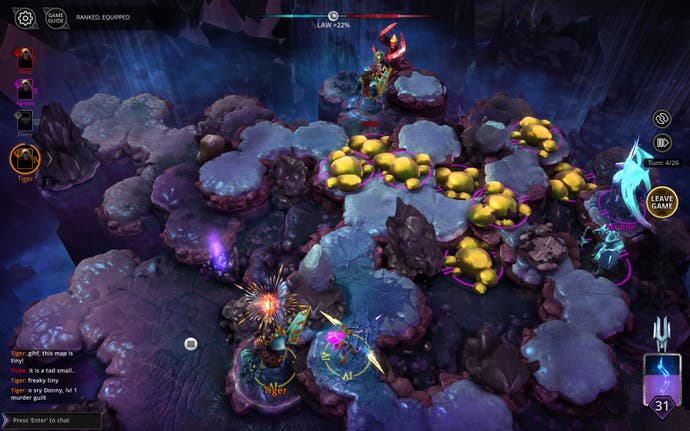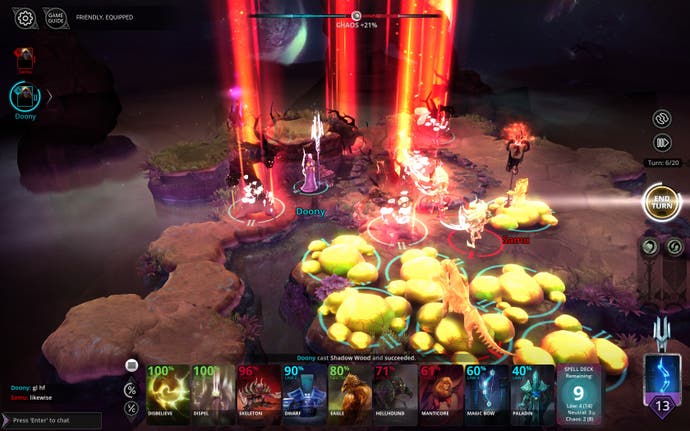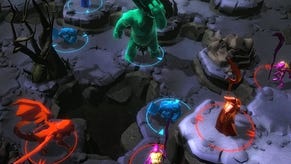Chaos Reborn review
The RNG cycle.
"GL, HF." As our own Rich Stanton once observed, only in StarCraft 2 would you need to remind players to have fun at the start of a video game multiplayer match. With Chaos Reborn, it's sort of the other way round: fun is pretty much guaranteed, but so is luck - good and bad luck, promoted to a position of supreme, and supremely mischievous, importance. It works, too. Chaos Reborn is strategy at its leanest - wizard versus wizard, racing around an arena, conjuring beasts and flinging spells in a swift battle to the death - but the role of luck, or, more specifically, RNG, ensures that every encounter is surprising, and often humbling.
I have a theory about this, actually, and it's worth getting it out of the way upfront. The theory concerns Chaos Reborn's community, which is atypically lovely. I'm not saying that most online games gather toxicity around them as a matter of course, but few, I suspect, are quite as friendly and inviting as this one is. This could be because the community's fairly small (I generally get a game within a minute or two of entering matchmaking, but there's rarely more than 10 matches going on at any time). Or It could be because everyone playing is a refugee from the old days of the glorious Spectrum version of Chaos, so it's all fellow travellers and aging friends. In truth, though, I have a feeling it's something to do with the game itself - with what happens on the field. In Chaos (and this is as true for the original as it is for the latest version) you can get almost everything right, and your opponent can get almost everything wrong, and yet there's still that matter of luck to contend with.
For a tactical game, this should be awful - and yet! And yet.
Chaos Reborn takes place in a world in which magic is real, but in which magic is also really tricky to pull off. Sometimes, when you reach for a spell it might not work. The first thing this means is that you're in a land of percentages from the start. Want to conjure a lion? From a standing start, there's a 70 per cent chance of that working out for you. Want to conjure a Sapphire Dragon? Those are a lot fancier: 20 per cent.

This matters in a game in which you only get to do one bit of casting per-turn. Each wizard has a very limited number of things they can do whenever it's their go: they can conjure a beast or a spell, they can move any beasts they've already conjured around the game's claustrophobic hex-based arenas, they can attack, both with beasts and by themselves if the opportunity presents itself, and they can mess around with the perks on their talismans. That's pretty much it. Waste a go - by taking a risk on a 20 per cent cast that fails to materialise, for example - and you will pay for it. This is because any creature can kill any other creature in Chaos' brutal world. A rat can kill an elephant. Each attack is either a successful kill or an absolute miss, and - once again - what controls that is, in part, a percentage game.
The reason this isn't completely maddening is simple. Beyond the little jolt of adrenalin such a system gives you whenever you successfully cast that lion, beyond the glee you feel when a hit that really should have killed you doesn't, and beyond the awful woe you encounter when a 96 per cent probability in your favour falls to the rogue four per cent, Chaos Reborn is a game about learning to shift the odds in your direction. Its maps have terrain of variable height, for example, and it's better to be on a hill punching down than in a ditch punching up - hence a tweak to those percentages for the cleverly positioned wizard. Equally, each of the spells you're given - beasts or magic attacks alike, they show up at the bottom of your screen as cards - not only has a percentage chance of working, but it has an alignment, Chaos, Law, or Neutral. And for Chaos and Law, you can shift the needle on this alignment by playing cards that match it, thus making the odds go up.
Let's say I have a killer Chaos spell: Shadow Wood, say, which is my absolute favourite. Shadow Wood allows you to plant trees around your foe which can attack each turn: a forest of flailing limbs! But the percentage chance of casting it from the off is middling, so you're encouraged to work towards it, casting cheaper, easier Chaos spells turn after turn, until a successful Shadow Wood becomes a real probability. This is tactical thinking, and it's also a reminder that luck is often part of a good tactical game anyway - especially when it's luck that can be tweaked by a skilful or thoughtful player.
And for Chaos Reborn, that's just the start. Let's say I have a card I really want to play, but the percentage chance of playing it is really low. I have a 20 per cent chance of conjuring a Sapphire Dragon, for example, and I can't really risk it. What I can do instead, however, is cast the Sapphire Dragon as an illusion. Illusions always cast successfully, This means that the dragon will still deal damage when it attacks enemies - and it will still win the game for me if it kills the enemy wizard - but my rival, if he suspects subterfuge, can cast a disbelieve spell on it, and it will vanish without a trace.

Subterfuge folds into tempo, in other words. If my enemy casts a disbelieve spell and he's correct, he gets to cast another spell: I will be one spell behind. If he's wrong, though - if he casts disbelieve and I wasn't offering up illusions, then he's behind, and I'm back ahead. Out of this simple twist - and it was present in the original game - Chaos Reborn draws much tension and much character. This isn't a game about just beating your enemy, in other words. It's a game about feeling that you were tricking them at the same time.
It helps that everything else is so nicely handled, of course: the fantasy visuals are lushly characterful with all those spindly elves and noble lions knocking about, the maps keep you moving, the turn-limits stop things from stagnating and the cards you're dealt have some real treats amongst them. Alongside Shadow Wood, another favourite is the Gooey Blob card that sticks enemies to the ground and can advance unpredictably from turn to turn, often screwing over whoever cast it. Equally, I love the Giant with his ranged axe, not least because he's such a low percentage that if you cast him successfully, you've got a good chance of getting a disbelieve wasted on you into the bargain.
There are other clever elements, too: weapons and mounts for your Wizard, and the ability to cash in cards and mana to either tilt the odds of casting a spell or to pay for the endearingly named Mega-Spells that can change the course of a battle. Mana is generated through burning cards, through kills and through spells you've cast that didn't work, and it can also be collected from nodes scattered across the map, encouraging you, in a game that's already all about managing risks, to be even more foolhardy.

Beyond this lies XP and gold, both of which are won in matches and the latter of which can be cashed in for random packs of items: staffs, which make certain spells available, offer different Mega-Spells, and can influence the cards that turn up in each randomised decks; bodygear that, amongst other things, changes the central stats of your wizard; talismans - active and inactive perks and buffs, some of which can ensure a favoured card turns up in your starting hand.
There's also an asynchronous mode and the Realms of Chaos, a sort of single-player RPG quest campaign system that I'm still, in truth, getting to grips with such is its generosity and depth. Ultimately, though, Realms offer surprisingly lengthy adventures in which one-shot battles are strung together into fantasy narratives, complete with exploration, simple choices, the ability to recruit allies and even game invasions from other players. I've given it an afternoon or two, and I'll admit that that's nowhere near enough time to get the measure of it, but it's a welcome addition - and the community seems to be behind it too, which is a bonus since it depends in part upon player-generated content.
Nice as all that is, of course, Chaos Reborn lives and dies, much as the original did, with its multiplayer: quick-paced, devious scraps for up to four players if you can find them. Will you be able to? I suspect the answer's yes. Chaos Reborn's probably not going to capture a huge audience, but I reckon the audience it does have is going to stick around. With its thrilling use of RNG, with its bluffing mechanics and its speedy matches that often conclude with a shocking abruptness, this was never going to be for everyone - but how many true classics really are?


















